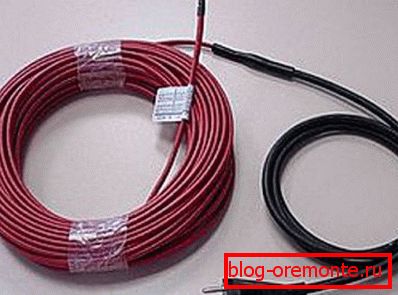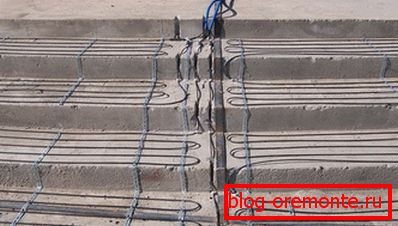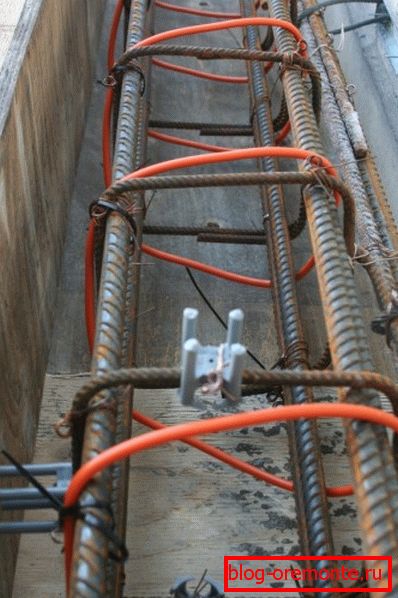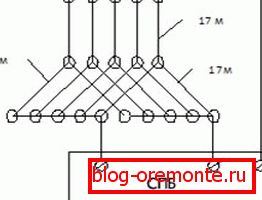Heating cable for concrete: requirements and parameters of
Under conditions of low temperatures, the thickening of concrete slows down significantly, as a result of which the concreting process in winter time can be greatly delayed. However, they have recently learned how to deal with this problem by using a special heating cable.

General information
Heating concrete with a heating wire is a widespread technology among professional builders. Its popularity is due to the cost-effectiveness of the method, since no heat losses occur during heating - all energy from the cable is transferred directly to the concrete. In addition, this technology is already well debugged.
Another advantage of this heating is the relatively low price of the wire. Therefore, it can be said that among all possible options, the considered method of heating concrete is the most appropriate.
So, the essence of this method is that before pouring concrete, a cable of a certain cross section and voltage level is mounted. Then the cable is poured with concrete and is connected to electricity, as a result of which the concrete begins to be heated.
There is an opinion that under the influence of temperatures, cracks can form in concrete and air bubbles can form. However, this is all speculation, in reality, the structure of concrete does not change, but the solution freezes much faster. As a result, the process of concreting can be accelerated several times.

The only thing, it is extremely important to observe the technology of installation of the system and the order of heating. Otherwise, the result can really disappoint.
As a rule, electric heating of concrete with a heating wire is used when pouring floors. Such heating can also increase the drying rate of other liquid building materials indoors or on the construction site. In particular, walls painted with paint or treated with a primer dry up faster, and putty and wallpaper glue freeze faster.
Wire Features
Basic cable requirements
The heating cable for heating the concrete must have certain properties, since it cannot be replaced later. In addition, any closure may cause a fire. Therefore, the choice of wire must be given special attention.
Most often for this purpose, a PNSV heating cable for concrete is used - a two-core steel wire with an insulating coating of polyester or polyvinyl chloride. Due to its reliable isolation, the possibility of ignition is excluded, in addition, the probability of fractures and kinks of the inner veins is also minimal.
Such wire can be used both in houses with single-phase wiring, and when it is split into three phases.

Key cable parameters
The main parameter of the heating wire is throughput. The best option is a cable with a nominal current level of up to 16 A. It is quite enough for private houses and apartments in high-rise buildings.
Another important feature of the heating wire is the presence of special branches, which lead out of the concrete area. These branches are called cold endings.
The principle of operation is based on the fact that the current heats the surface of the cable, but the concrete itself is cold. Thus, it turns out a kind of energy compensation. However, if the ends of the wire are heated, then there is a high probability that they will melt or even short.

Application area
The heating wire can be used in the following cases:
- For heating household and industrial premises;
- For installation on busbars;
- For temporary heating of construction sites;
- For heating foundations, floors, concrete fences, etc.

Concrete heating technology
System installation
Do-it-yourself wire installation for concrete is quite a serious procedure that requires certain knowledge (find out here what concrete lacquer is for).
Note! Before pouring, it is necessary to think in advance about laying down communications or the presence of holes in concrete. After installing the system and pouring concrete, all surface operations can damage the cable. If you still need to perform, for example, diamond drilling of holes in concrete, then you must first make sure that there is no heating wire in this place.
Work is performed in the following order:
- First of all, you need to clean the surface from debris and various sharp parts that can damage the wire.
- Then the reinforcement or reinforcement mesh is laid, and the reinforcement is welded.
- Then the wire is installed.but. The easiest way - laying snake. Its value will depend on the pouring area and cable length. At the same time, do not forget that it is strictly forbidden to lay wires on top of one another, in addition, it is necessary to ensure that the cable does not touch the formwork and does not protrude beyond the concrete surface.

The optimal distance between the cables is no more than 15 centimeters, especially if there is a long wire, and the fill area is small.
- Next you need to check the system for operation - connect to electricity and make sure that the cable heats up. Be sure to control the power current.
Do not exceed the figures specified by the manufacturer on the wire. If the system will be operated without a transformer, which allows to reduce the amount of current, then PTPZh wire should be used, as it is more powerful.
- After that, you need to unplug the cable and let it cool.
- The final stage is to fill the area with concrete..
Note! When installing the cable it is extremely important not to allow it to be bent. The wire should lie soft semicircle. This will avoid the so-called "white zones" and at the same time not to break the veins.

As we can see, the installation of a concrete heating system with a wire in many ways resembles the installation of a heated floor. Moreover, this cable is quite possible to use for these purposes. The only thing, in this case, it is more expedient to make a heater from the strands of the wire and wrap it with insulating material.
If a separate power station is used, then it is better to use a star connection scheme. It is more effective than the "snake" and is well suited for heating small areas.
Tip! If over time you need to dismantle the concrete surface, then the most effective way is to cut the concrete with diamond circles in combination with the use of a jackhammer.

The order of heating concrete
Instructions for heating concrete cable is as follows:
- After the area is completely covered with concrete, the heating system is started.. In this case, the rate of temperature increase should be no more than ten degrees Celsius in two hours.
- Next begins the main warm-up period. At this stage, you need to make sure that the temperature does not reach 80 degrees Celsius.
- The final stage is cooling.. The rate of temperature reduction should be no more than five degrees per hour.
Note! Operation of the system must be done very carefully, minimizing the possibility of voltage drops. Therefore, it is necessary to use a stabilizer, otherwise the cable will fuse and dismantle it will be impossible.
At this process, the heating of concrete is completed. With strict compliance with the instructions, the material will be able to achieve the required level of strength even in conditions of very low temperatures.
Conclusion
Греющий провод для бетона позволяет не откладывать строительные работы до наступления теплой погоды. Единственное, для успешного бетонирования необходимо соблюдать технологию его монтажа и инструкцию по эксплуатации системы (см.также статью «Термометр для бетона: назначение и виды»).
After the concrete hardens, the cable can be used to further heat the room. From the video in this article you can get more information on this topic.